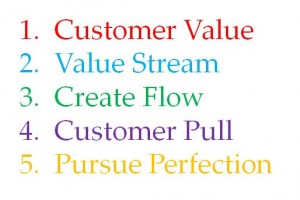 I’m getting lean. Alas, this is not about my body. It’s something I’ll call “lean communication.” I’m not about to preach on short sentences and plain words, though that can be part of it. I’m convinced that good communication reduces waste.
I’m getting lean. Alas, this is not about my body. It’s something I’ll call “lean communication.” I’m not about to preach on short sentences and plain words, though that can be part of it. I’m convinced that good communication reduces waste.
In manufacturing, the concept of “lean” describes practices that use fewer resources to provide greater value to customers. Anything customers don’t value enough to pay for is considered “waste,” something to eliminate. Lean practices originated in manufacturing in the 1940s, when Taiichi Ohno introduced them at Toyota. Over the years, they’ve been adopted and adapted in many contexts, including lean startups and lean software development.
When I look at the ideas I use with my communication coaching clients, I see a lot of overlap with lean principles, particularly those set out by the Lean Enterprise Institute. I’ve paraphrased them, but you can find the original version here.
1. Establish value from the customer’s perspective
This is my top tip for communication. I never tire of sharing it because it works so well. The audience for any communication might be considered your “customers.” The more you can make your communication about them and their needs, the more likely you are to be listened to, heard and understood. Whether you’re addressing one person or 100, in conversation, in presentations, in broadcast or in writing, you can almost never go wrong if you explain your point from the perspective of your audience. You make people care about your message by answering their question, “What’s in it for me?” (WIFM) That’s the value will it have for them. When you talk about anything they don’t value – no matter how much you love it – you waste your time and theirs.
2. Identify the steps, eliminating anything that doesn’t create value
To identify the steps that create value for your audience, answer these questions:
- Who is my audience and what do they need to know about this? (Know your audience.)
- What do I want them to do as a result of this communication? (Clarify your purpose.)
- What will doing that mean for them? (Identify the impact or benefit of your idea – the WIFM.)
- What are the three (or fewer) most critical elements? (Clarify and streamline your message.)
- How do I make this idea come to life? (Support your point with brief stories/examples.)
- How will I reach them? (Decide how to communicate with them – face-to-face, written, etc.)
- How will I make the communication two-way? (Ask questions. Pay attention to the answers.)
- Why are we doing this? (Invite questions so you’ll know what’s important to them.)
One question you don’t have to wait for is, “Why?” Be sure to include the reasons for the request or change you’re introducing.
3. Put steps in a tight sequence so product flows smoothly to customers
In this case, the product is your idea or message. The customers are your audience. There are two tactics to try here.
The first is to get rid of every idea that doesn’t pay its way by creating clarity and understanding. Be clear, not clever. This is where plain language and short sentences come into play. Make it really hard to misunderstand you. A confused mind always says, “No!”
People need enough context to understand what you say, but let’s not overwhelm them with everything you think, feel and know about the topic. Focus on the ideas or instructions that will interest or help your audience. If they tune out, you’ve not only wasted your time and theirs, you’ve invited misunderstanding and mistakes.
Having some structure helps just about any activity, and communicating is no exception. That’s the second tactic.
- The Direct Approach sounds like this: “Here’s what I think we should do. Here’s a fact that supports it. Here’s another. And here’s another.” You state your idea, then provide the evidence to back it up.
- The Indirect Approach sounds like this: “Here’s a fact. Here’s another. And here’s another. Here’s what I think we should do.” You line up a bunch of clues you hope will lead people to your conclusion.
The Direct Approach is, usually, more successful in keeping people’s attention. They don’t have to wonder, “Where is this going?” They know because you told them.
4. Let customers pull value from the next activity
When I think of this principle in the context of communication, I see people who are looking forward to hearing what you have to say. They’re ready, able and willing to hear and process what you say next. Using the direct approach, above, encourages this by helping them follow your thinking sequence.
Another technique is to let them know how the communication will unfold. Let’s call this “placement.” For example, you might let them know that you’d like to explain something first, then have a discussion or that you’ll take questions throughout. Either way, they know they’ll have a chance for input. And if you’re using written communication, give them a way to participate in a discussion.
5. Repeat until you create perfect value with no waste
Each time we practice conscious conversation, rather than operating from habit, we get a better conversation. We may never get it perfect but, as we get better at creating connection with others and communicating cleanly, we reduce the waste that comes from having to repeat information or, worse, from the mistakes that result from misunderstanding.
